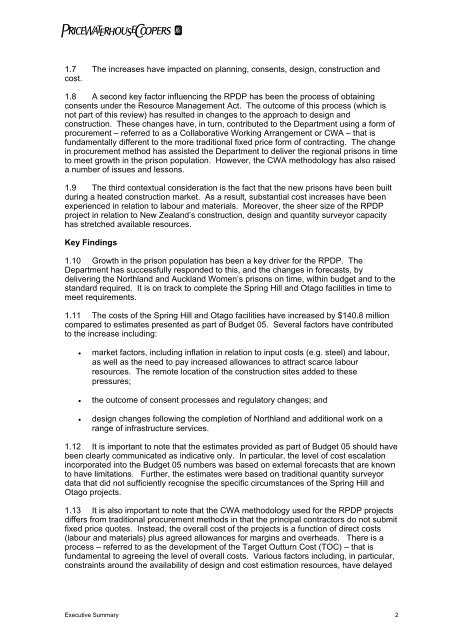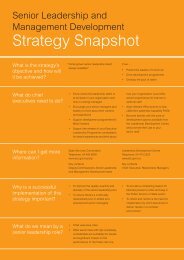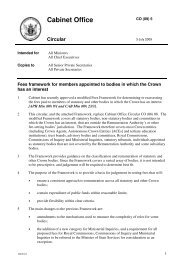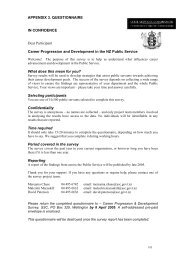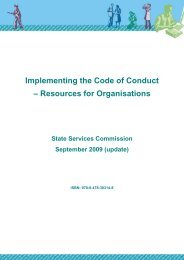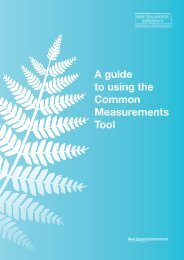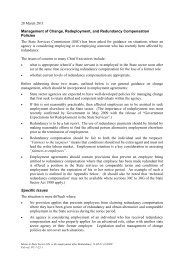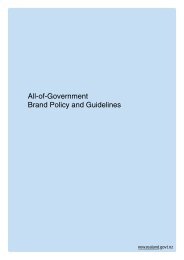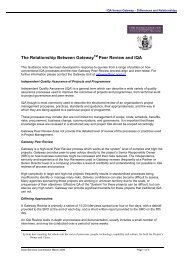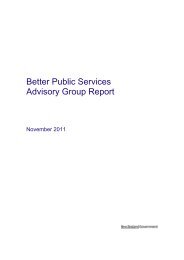NZ Report / Proposal Template - State Services Commission
NZ Report / Proposal Template - State Services Commission
NZ Report / Proposal Template - State Services Commission
You also want an ePaper? Increase the reach of your titles
YUMPU automatically turns print PDFs into web optimized ePapers that Google loves.
1.7 The increases have impacted on planning, consents, design, construction and<br />
cost.<br />
1.8 A second key factor influencing the RPDP has been the process of obtaining<br />
consents under the Resource Management Act. The outcome of this process (which is<br />
not part of this review) has resulted in changes to the approach to design and<br />
construction. These changes have, in turn, contributed to the Department using a form of<br />
procurement – referred to as a Collaborative Working Arrangement or CWA – that is<br />
fundamentally different to the more traditional fixed price form of contracting. The change<br />
in procurement method has assisted the Department to deliver the regional prisons in time<br />
to meet growth in the prison population. However, the CWA methodology has also raised<br />
a number of issues and lessons.<br />
1.9 The third contextual consideration is the fact that the new prisons have been built<br />
during a heated construction market. As a result, substantial cost increases have been<br />
experienced in relation to labour and materials. Moreover, the sheer size of the RPDP<br />
project in relation to New Zealand’s construction, design and quantity surveyor capacity<br />
has stretched available resources.<br />
Key Findings<br />
1.10 Growth in the prison population has been a key driver for the RPDP. The<br />
Department has successfully responded to this, and the changes in forecasts, by<br />
delivering the Northland and Auckland Women’s prisons on time, within budget and to the<br />
standard required. It is on track to complete the Spring Hill and Otago facilities in time to<br />
meet requirements.<br />
1.11 The costs of the Spring Hill and Otago facilities have increased by $140.8 million<br />
compared to estimates presented as part of Budget 05. Several factors have contributed<br />
to the increase including:<br />
• market factors, including inflation in relation to input costs (e.g. steel) and labour,<br />
as well as the need to pay increased allowances to attract scarce labour<br />
resources. The remote location of the construction sites added to these<br />
pressures;<br />
• the outcome of consent processes and regulatory changes; and<br />
• design changes following the completion of Northland and additional work on a<br />
range of infrastructure services.<br />
1.12 It is important to note that the estimates provided as part of Budget 05 should have<br />
been clearly communicated as indicative only. In particular, the level of cost escalation<br />
incorporated into the Budget 05 numbers was based on external forecasts that are known<br />
to have limitations. Further, the estimates were based on traditional quantity surveyor<br />
data that did not sufficiently recognise the specific circumstances of the Spring Hill and<br />
Otago projects.<br />
1.13 It is also important to note that the CWA methodology used for the RPDP projects<br />
differs from traditional procurement methods in that the principal contractors do not submit<br />
fixed price quotes. Instead, the overall cost of the projects is a function of direct costs<br />
(labour and materials) plus agreed allowances for margins and overheads. There is a<br />
process – referred to as the development of the Target Outturn Cost (TOC) – that is<br />
fundamental to agreeing the level of overall costs. Various factors including, in particular,<br />
constraints around the availability of design and cost estimation resources, have delayed<br />
Executive Summary 2


